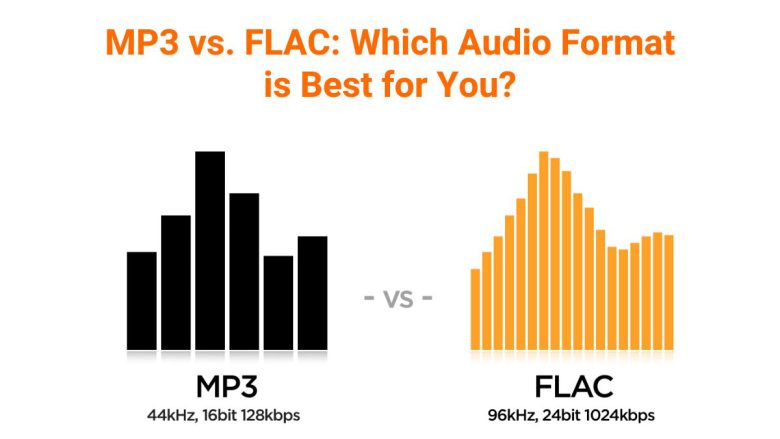
In digital audio, picking the right format for your music or projects is key. It can greatly impact your listening experience. Two of the most popular audio formats are MP3 and FLAC. Each has its own advantages and limits. They cater to different needs and preferences. This blog post delves into MP3 and FLAC. It compares their features, benefits, and use cases. This will help you decide which audio format is best for you.
Understanding MP3 and FLAC
MP3 Format
MP3 is short for MPEG-1 Audio Layer 3. It is a popular audio format that has become linked with digital music. The Moving Picture Experts Group (MPEG) developed MP3 in the early 1990s. It revolutionized music storage and sharing by greatly reducing file sizes.
Key Features of MP3:
- Lossy Compression: MP3 uses lossy compression to reduce file size by removing audio data that is considered less important for human hearing. This results in smaller files but at the expense of some audio quality.
- Wide Compatibility: MP3 is universally supported by virtually all digital audio players, smartphones, and computers, making it the most compatible audio format.
- Variable Bitrates: MP3 supports various bitrates, allowing users to choose a balance between file size and audio quality. Common bitrates include 128 kbps, 192 kbps, and 320 kbps.
- Efficient Storage: Due to its compressed nature, MP3 files take up less storage space, making them ideal for portable devices with limited capacity.
FLAC Format
FLAC is short for Free Lossless Audio Codec. It is an open-source audio format. It offers lossless compression. The Xiph.Org Foundation developed FLAC in the early 2000s. Audiophiles and music enthusiasts like it. It preserves audio quality.
Key Features of FLAC:
- Lossless Compression: FLAC compresses audio files without any loss of quality, retaining the original sound fidelity. This means that FLAC files sound identical to the original recordings.
- High-Resolution Audio: FLAC supports high-resolution audio, allowing for better sound quality compared to lossy formats like MP3.
- Open Source and Royalty-Free: FLAC is an open-source format, meaning it is free to use and not subject to licensing fees.
- Large File Sizes: Due to its lossless nature, FLAC files are significantly larger than MP3 files, requiring more storage space.
Comparing MP3 and FLAC
To find the best format for you, you must compare MP3 and FLAC. You must look at several key factors:
1. Audio Quality
- MP3: The lossy compression used in MP3 files results in some loss of audio quality. High-bitrate MP3s (such as 320 kbps) can sound good. But, there is still a noticeable difference when compared to the original recording. This is especially true for audiophiles or in high-fidelity sound systems.
- FLAC: FLAC files offer superior audio quality because they are lossless. This means they keep the full detail and depth of the original recording. This makes them the best choice for high-resolution audio and critical listening.
2. File Size and Storage
- MP3: One of the primary advantages of MP3 is its small file size. By using lossy compression, MP3 files are typically 5-10 times smaller than FLAC files, making them ideal for portable devices and large music libraries.
- FLAC: FLAC files are much larger due to their lossless nature. While this ensures better audio quality, it also means they require more storage space. This can be a drawback for users with limited storage capacity.
3. Compatibility and Playback
- MP3: MP3 is the most widely supported audio format, compatible with almost all digital audio players, smartphones, computers, and even car stereos. This universal compatibility makes it a convenient choice for everyday use.
- FLAC: While FLAC is supported by many modern devices and media players, it is not as universally compatible as MP3. Some old devices may not play FLAC. Users may need to install extra software to play FLAC on some platforms.
4. Use Cases and Applications
- MP3: MP3 is ideal for casual listening, portable music libraries, and situations where storage space is a concern. It is also good for streaming services and online music stores. This is because of its small size and wide compatibility.
- FLAC: FLAC is best suited for audiophiles, music enthusiasts, and professionals who prioritize audio quality over file size. It is also great for archiving music. It keeps the original sound.
5. Editing and Conversion
- MP3: Due to its lossy nature, editing MP3 files can further degrade their quality. Additionally, converting MP3 files to other formats may result in additional quality loss.
- FLAC: FLAC files are more suitable for editing and conversion because they are lossless. You can edit FLAC files without reducing audio quality. Converting them to other formats will keep the original fidelity.
Read How to Convert MP4 to MP3 Online.
Choosing the Right Format for Different Scenarios
The choice between MP3 and FLAC depends on your specific needs and preferences. Here are some common scenarios and recommendations:
1. Casual Listening and Portable Devices
You mainly listen to music on portable devices, like smartphones or MP3 players. They have limited storage space. MP3 is the best choice. Its small size lets you store more songs. Its compatibility ensures you can play your music on almost any player.
2. High-Quality Audio and Critical Listening
FLAC is better for critical listening. It’s for high-resolution audio and use with high-fidelity sound systems. It uses lossless compression. This keeps you from losing the full detail and richness of the original recordings. This makes it the top choice for audiophiles and music pros.
3. Archiving and Preserving Music
When archiving or preserving your music collection, FLAC is the superior choice. It doesn’t lose data, so you get a high-quality, unaltered copy of your music. You can convert it to other formats without any loss of quality.
4. Streaming and Online Music Stores
Streaming services and online music stores often prefer MP3. This is due to its small file size and efficient streaming. Some services offer FLAC for high-res audio. But, MP3 is still the top format for streaming.
Practical Tips for Using MP3 and FLAC
Use any format. Here are some tips to help you manage and enjoy your digital music collection:
1. Organize Your Music Library
Keep your music library well-organized. Do this by using consistent names, accurate metadata, and folders by artist, album, or genre. This makes it easier to find and enjoy your music.
2. Backup Your Collection
Regularly backup your music collection to prevent data loss. Use external hard drives, cloud storage, or both to ensure that your music is safe and accessible.
3. Use High-Quality Playback Devices
Invest in high-quality playback devices. These include good headphones, speakers, and digital audio players. They let you fully appreciate your music’s audio quality. This is especially true if you use FLAC files.
4. Convert Formats as Needed
Use reliable audio conversion software to convert between formats as needed. If you have many FLAC files, you can make MP3 copies for portable devices. This lets you keep the FLAC files for archiving.
Conclusion
Choosing the right audio format is crucial. It ensures the best listening. MP3 and FLAC each offer unique advantages. They cater to different preferences and use cases. MP3 is great for casual listening and portable devices. It’s also for situations where storage space matters. FLAC is the best for high-quality audio, critical listening, and archiving.
By understanding the differences between MP3 and FLAC. And by considering your needs. You can make an informed choice. It will enhance your enjoyment of digital music. The right format will help you get the most from your music. This is true whether you are a casual listener, an audiophile, or a music professional.


